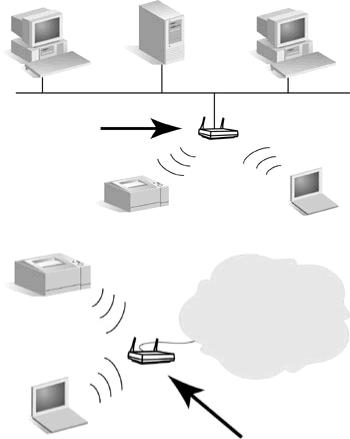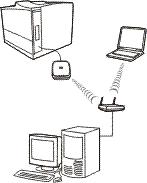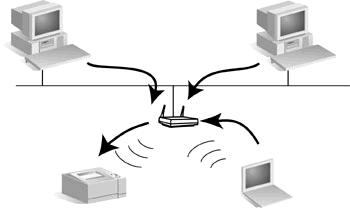HP Jetdirect ew2500 Setup and Install

HP Jetdirect ew2500
802.11g Wireless Print Server
Setup Guide

HP Jetdirect ew2500 802.11g Wireless Print
Server
Setup Guide
© 2004-2014 Copyright Hewlett-Packard
Development Company, L.P.
Reproduction, adaptation or translation without prior written permission is prohibited, except as allowed under the copyright laws.
The information contained herein is subject to change without notice.
The only warranties for HP products and services are set forth in the express warranty statements accompanying such products and services. Nothing herein should be construed as constituting an additional warranty. HP shall not be liable for technical or editorial errors or omissions contained herein.
Applicable products: J8021A
Edition 2, 11/2014
Microsoft®, MS-DOS®, Windows®, Microsoft Windows NT® are trademarks or U.S. registered trademarks of Microsoft Corporation. IBM®, AIX® are registered trademarks of International Business Machines Corp. Ethernet is a registered trademark of Xerox Corporation. PostScript® is a trademark of Adobe Systems, Incorporated. UNIX® is a registered trademark of the Open Group.
Windows Vista™ is either a registered trademark or trademark of Microsoft Corporation in the United States and/or other countries.

Table of contents
1 |
Introduction |
|
|
What's in the box .................................................................................................................................. |
1 |
|
What you need to supply ...................................................................................................................... |
2 |
|
Test button functions ............................................................................................................................ |
3 |
|
Wireless LAN terms and concepts ...................................................................................................... |
4 |
|
Access Point ........................................................................................................................ |
4 |
|
Ad Hoc (peer-to-peer) mode ................................................................................................ |
5 |
|
Channels .............................................................................................................................. |
5 |
|
Encryption ............................................................................................................................ |
6 |
|
Infrastructure mode .............................................................................................................. |
6 |
|
Security type ........................................................................................................................ |
7 |
|
Service Set Identifiers (SSID) .............................................................................................. |
8 |
|
Signal range ......................................................................................................................... |
8 |
|
Network printing terms and concepts .................................................................................................. |
8 |
|
Client-server printing ............................................................................................................ |
8 |
|
Peer-to-peer (direct mode) printing ...................................................................................... |
9 |
|
Network protocols ................................................................................................................ |
9 |
|
Network address .................................................................................................................. |
9 |
|
Hardware address ............................................................................................................... |
9 |
|
If you need help... ................................................................................................................................. |
9 |
2 |
Install the print server hardware |
|
|
Set up the printer ................................................................................................................................ |
11 |
|
If the printer is already set up ............................................................................................ |
11 |
|
If the printer is not already set up ...................................................................................... |
11 |
|
Connect the print server to the printer ............................................................................... |
11 |
3 Make a network connection |
|
|
|
Configure a wireless network using the network (LAN) cable ............................................................ |
13 |
|
Use a Microsoft Windows wireless PC .............................................................................. |
14 |
|
Configure settings for a wired network ............................................................................................... |
17 |
|
Use an Apple Macintosh wireless computer ...................................................................................... |
18 |
|
Configure a wireless network without a network (LAN) cable ............................................................ |
18 |
|
Factory-default wireless settings ....................................................................................... |
20 |
ENWW |
iii |
Optional wireless connection setup methods ..................................................................................... |
21 |
4 Install the printer on a network system or server |
|
Microsoft client-server networks ......................................................................................................... |
26 |
5 Troubleshooting |
|
Reset the print server to factory defaults (“cold reset”) ...................................................................... |
28 |
Interpret the status lights .................................................................................................................... |
29 |
Unable to communicate with the print server (wireless) ..................................................................... |
31 |
During initial setup ............................................................................................................. |
31 |
After initial setup ................................................................................................................ |
31 |
My configured channel does not match the configuration page ......................................................... |
32 |
Improve reception and performance .................................................................................................. |
32 |
Firmware download failure ................................................................................................................. |
33 |
Appendix A Service and support |
|
Hewlett-Packard limited warranty statement ...................................................................................... |
34 |
Your authorized dealer ...................................................................................................... |
35 |
Service billing (out of warranty) ......................................................................................... |
35 |
Service outside the USA .................................................................................................... |
36 |
Local warranty statements ................................................................................................................. |
36 |
Australia and New Zealand ................................................................................................ |
36 |
Customer support ............................................................................................................................... |
36 |
HP support online .............................................................................................................. |
36 |
HP support by phone ......................................................................................................... |
36 |
Product accessibility ........................................................................................................................... |
36 |
Appendix B Solution summary |
|
HP support software ........................................................................................................................... |
37 |
Embedded services ............................................................................................................................ |
37 |
Supported network protocols .............................................................................................................. |
38 |
Appendix C Specifications |
|
Electrical (power adapter) .................................................................................................................. |
40 |
Environmental .................................................................................................................................... |
41 |
Electromagnetic .................................................................................................................................. |
41 |
Acoustic .............................................................................................................................................. |
41 |
Radio characteristics .......................................................................................................................... |
42 |
iv |
ENWW |
HP subassemblies ............................................................................................................. |
42 |
Channel frequencies .......................................................................................................... |
42 |
Safety ................................................................................................................................................. |
42 |
Wireless telecommunications ............................................................................................................. |
42 |
Appendix D Regulatory statements |
|
FCC statement ................................................................................................................................... |
43 |
Regulatory Model Identification Number ............................................................................................ |
44 |
Canada ............................................................................................................................................... |
44 |
VCCI (Japan) ...................................................................................................................................... |
44 |
RRL statement (Korea) ...................................................................................................................... |
44 |
Regulatory wireless statements ......................................................................................................... |
45 |
Exposure to radio frequency radiation ............................................................................... |
45 |
Notice to users in Argentina ............................................................................................... |
45 |
Notice to users in Brazil ..................................................................................................... |
45 |
Notice to users in Canada ................................................................................................. |
46 |
European Union regulatory notice ..................................................................................... |
46 |
Notice to users in Indonesia .............................................................................................. |
47 |
Notice to users in Korea .................................................................................................... |
47 |
Notice to users in Mexico ................................................................................................... |
47 |
Notice to users in Pakistan ................................................................................................ |
47 |
Notice to users in Singapore .............................................................................................. |
47 |
Notice to users in South Africa .......................................................................................... |
47 |
Notice to users in Taiwan .................................................................................................. |
48 |
ENWW |
v |
vi |
ENWW |

1 Introduction
Thank you for purchasing the HP Jetdirect ew2500 802.11g Wireless Print Server! This print server complies with IEEE 802.11g wireless standards.
Use the HP Jetdirect ew2500 802.11g Wireless Print Server to directly connect your compatible HP printer to your network using either a wired or wireless connection.
●What's in the box
●What you need to supply
●Test button functions
●Wireless LAN terms and concepts
●Network printing terms and concepts
●If you need help...
What's in the box
1USB cable
2Network (LAN) cable
3External power adapter
4HP Jetdirect ew2500 802.11g Wireless Print Server
*Warranty card (where applicable)
ENWW |
What's in the box 1 |

What you need to supply
●A supported Microsoft Windows or Apple Macintosh computer with the included Network (LAN) cable to configure wired and/or wireless settings.
For a wireless network: an 802.11b or 802.11g wireless LAN (WLAN) interface card installed in the computer.
 NOTE: Use the included LAN cable to avoid possible radio interference problems during installation. After installation, you can remove the cable.
NOTE: Use the included LAN cable to avoid possible radio interference problems during installation. After installation, you can remove the cable.
◦Microsoft Windows XP, Vista, Server 2003, or Server 2008.
◦Apple Mac OS X 10.2 and later.
◦UNIX/Linux: Hewlett-Packard HP-UX, Sun Microsystems Solaris, IBM AIX, HP MPE-i, RedHat Linux, SuSE Linux
If your network is entirely wireless, then a wireless computer is needed to set up a wireless connection from your printer to your network.
●For wireless infrastructure mode only: a wireless router, access point, or Apple base station.
In infrastructure mode, an access point is a device that connects wireless devices, such as a wireless network printer, to your cabled network. See Wireless LAN terms and concepts
on page 4 for more information.
●For Windows systems: the printer’s software driver for your Windows system. You can obtain your printer driver from one of the following sources:
◦printing system CD-ROM supplied with your printer
◦HP support Web site at: www.hp.com/go/support.
2 Chapter 1 Introduction |
ENWW |

Test button functions
The test button, which is located on the back of the HP Jetdirect ew2500 print server, provides various functions depending on the number of the times the button is pressed. These functions can be useful during the installation process.
 NOTE: Typically, you press the button the indicated number of times in quick succession. However, some options provide additional functionality when holding the last button press.
NOTE: Typically, you press the button the indicated number of times in quick succession. However, some options provide additional functionality when holding the last button press.
Table 1-1 Test button instructions
Button Presses |
Function |
Instructions and Status Light (if applicable) |
|
|
|
1 |
Print an HP Jetdirect configuration |
Changes to blinking green for approximately five seconds. |
|
page. |
|
|
|
|
2 |
Print an HP Jetdirect security page. |
|
|
|
|
3 |
Print an HP Jetdirect configuration |
On the third press, hold the button down until the status light begins |
|
page in English, French, Italian, |
blinking, and then release the button. The configuration page prints |
|
German, or Spanish. |
in all languages. |
4Print an HP Jetdirect wireless status page.
5Change the LAN speed/handshake. On the fifth press, hold the button down until the status light begins
|
This is only for switches that do not |
blinking, then release the button. |
|
|
have auto negotiation mode set, |
Select from the following speed/handshake combinations (displayed |
|
|
|
||
|
Select from the following speeds/ |
three times): |
|
|
handshake: 10 Mbps. half-duplex, 10 |
● |
Blinking amber — 10 half-duplex |
|
Mbps. full-duplex, 100 Mbps. half- |
||
|
duplex, or 100 Mbps. full-duplex. |
● |
Solid amber — 10 full-duplex |
|
|
||
|
|
● |
Blinking green — 100 half-duplex |
|
|
● |
Solid green — 100 full-duplex |
|
|
To select a speed/handshake: |
|
|
|
1. |
Press and release the test button when the color associated with |
|
|
|
the speed/handshake you want is displayed. (The test button |
|
|
|
turns off then displays the selected color.) |
|
|
2. |
If the speed is correct (indicated by the test button color), press |
|
|
|
and release the test button once to confirm. |
|
|
3. |
If the speed/handshake is not correct (indicated by the test |
|
|
|
button color), do not press the test button. The change is not |
|
|
|
made. You can then start over and change the speed/ |
|
|
|
handshake. |
|
|
4. |
To complete (save) the change, power cycle the print server. |
|
|
|
|
6 |
Reset 802.1x to factory default |
To complete (save) the change, power cycle the print server. |
|
|
values. |
|
|
|
|
|
|
7 |
Disable IPsec. |
To complete (save) the change, power cycle the print server. |
|
|
|
|
|
ENWW |
Test button functions 3 |

Wireless LAN terms and concepts
Access Point
An Access Point is a device that typically serves as a bridge or gateway between wireless devices and the devices on a cabled network. An Access Point must be able to receive and forward network traffic between wireless and cabled network devices. Multiple Access Points can act as repeaters to extend the range of a wireless network.
Connecting via an access point is called Infrastructure Mode. On Apple networks, this is called Airport Network Mode.
Figure 1-2 Access Point in enterprise workgroup
Figure 1-3 Residential gateway as Access Point
4 Chapter 1 Introduction |
ENWW |

Figure 1-4 Access Point as wireless repeater
Ad Hoc (peer-to-peer) mode
Ad Hoc mode (or peer-to-peer mode) is a wireless network topology where wireless devices communicate with each other directly. An Access Point is not used. On Apple networks, Ad Hoc mode is called computer-to-computer mode.
 NOTE: Ad Hoc mode is not as reliable as Infrastructure mode, and if used, should be limited to six devices or less.
NOTE: Ad Hoc mode is not as reliable as Infrastructure mode, and if used, should be limited to six devices or less.
When set in this mode, the HP Jetdirect print server receives print jobs from wireless computers directly.
Figure 1-5 Ad Hoc mode: a peer-to-peer wireless network topology
 NOTE: The term “peer-to-peer” might have a different meaning depending on its usage. While Ad Hoc peer-to-peer mode refers to a wireless network topology, HP Jetdirect peer-to-peer printing refers to a direct print path from a network computer to a printer. HP Jetdirect peer-to-peer printing can be used on both Ad Hoc or Infrastructure wireless topologies.
NOTE: The term “peer-to-peer” might have a different meaning depending on its usage. While Ad Hoc peer-to-peer mode refers to a wireless network topology, HP Jetdirect peer-to-peer printing refers to a direct print path from a network computer to a printer. HP Jetdirect peer-to-peer printing can be used on both Ad Hoc or Infrastructure wireless topologies.
Channels
IEEE standards for 802.11b and 802.11g wireless LANs specify a spectrum of radio waves for wireless communications. The allowed spectrum is divided into channels consisting of 22 MHz each. The number
ENWW |
Wireless LAN terms and concepts 5 |

of available channels authorized for use may be restricted based on your location (see Radio characteristics on page 42).
●If the print server is powered on and discovers a wireless network whose SSID (network name) is also “hpsetup”, it will automatically adjust its channel to match that network.
●If the print server is reconfigured for Infrastructure mode, it will automatically adjust its channel to match the Access Point.
Encryption
Wireless networks use radio signals for network communications, which can be easily monitored by someone eavesdropping on the network. To deter eavesdropping and to help ensure data privacy, encryption of wireless communications may be used.
For HP Jetdirect print servers in their factory-default state, encryption of wireless communications is disabled. However, the print servers support static WEP and popular dynamic encryption protocols.
 NOTE: Wireless performance may be reduced when using encryption keys due to the additional processing time required.
NOTE: Wireless performance may be reduced when using encryption keys due to the additional processing time required.
Static Encryption. WEP encryption protocols were developed to provide a basic level of data privacy. WEP protocols use static encryption keys to encrypt and decrypt wireless communications.
 NOTE: WEP encryption levels are sometimes called 40-bit, 64-bit, 104-bit, or 128-bit encryption. Both 40-bit and 64-bit encryption are really the same, as are 104-bit and 128-bit encryption. When entering WEP keys, the user specifies 40 bits for 64-bit encryption, or 104 bits for 128-bit encryption. An additional 24 initialization vector (IV) bits are automatically added for a total of 64 bits and 128 bits, respectively. In this guide, we will use “40/64-bit” and “104/128bit” to specify these WEP encryption levels.
NOTE: WEP encryption levels are sometimes called 40-bit, 64-bit, 104-bit, or 128-bit encryption. Both 40-bit and 64-bit encryption are really the same, as are 104-bit and 128-bit encryption. When entering WEP keys, the user specifies 40 bits for 64-bit encryption, or 104 bits for 128-bit encryption. An additional 24 initialization vector (IV) bits are automatically added for a total of 64 bits and 128 bits, respectively. In this guide, we will use “40/64-bit” and “104/128bit” to specify these WEP encryption levels.
For basic encryption, static WEP keys are configured on each device on the wireless network. WEP keys are considered static because they remain the same unless manually reconfigured. For example, on a typical Infrastructure mode network that uses static WEP encryption, a change to the WEP key on an Access Point will require a manual change to the WEP key on each wireless device.
HP Jetdirect wireless print servers support configuration of up to four static WEP keys, for either 40/64bit or 104/128-bit encryption.
Dynamic Encryption. For advanced encryption methods, dynamic encryption protocols are used. For dynamic encryption protocols, encryption keys are automatically changed at routine intervals making them difficult to decipher.
Dynamic encryption protocols, such as dynamic WEP and wi-fi protected access (WPA/WPA2), provide a more secure wireless environment.
When configured for WPA/WPA2–Personal authentication, HP Jetdirect print servers use WPA encryption.
Infrastructure mode
Infrastructure mode is a wireless network topology where all wireless communications go through an Access Point. Infrastructure mode is called a Basic Service Set (BSS), and sometimes referred to as “enterprise mode.” On Apple networks, Infrastructure mode is called Airport Network mode. When set
6 Chapter 1 Introduction |
ENWW |

in this mode, the HP Jetdirect print server receives print jobs from wireless and cabled network computers through an Access Point.
Figure 1-6 Infrastructure mode: a wireless topology that uses an Access Point for connection to a wired network
Security type
Security is used to validate the identification of each device or computer that is attempting to access a network. The security type used on a network is determined during network design and depends on the network security requirements. Consequently, security methods are closely associated with encryption options that are also used on the network.
HP Jetdirect wireless print servers support the following security types:
●No security. No encryption or authentication is used. Open system. Your wireless network does not require device authentication or security to access the network. However, your network might use WEP encryption keys for data privacy.
●WEP-Personal. Each device on your wireless network uses a shared encryption key (a shared password value) for network access and communication. Each device on the network must use the same key. The HP Jetdirect print server supports IEEE 802.11 WEP keys for encrypted network communications.
●WEP-Enterprise. The network uses WEP with EAP/802.1x authentication. This type of security utilizes a central authentication server, such as RADIUS, to authenticate users on the network. The HP Jetdirect print server supports these server-based authentication protocols: LEAP, PEAP, and EAP-TLS.
●WPA/WPA2–Personal. Your network uses wi-fi protected access (WPA) with a pre-shared key that is typically generated by a pass-phrase. WPA encryption is normally used for wireless communication and offers improved security.
●WPA/WPA2–Enterprise. Your network uses WPA with EAP/802.1x authentication. This type of security utilizes a central authentication server, such as RADIUS, to authenticate users on the network. The HP Jetdirect print server supports these server-based authentication protocols: LEAP, PEAP, and EAP-TLS.
ENWW |
Wireless LAN terms and concepts 7 |

Service Set Identifiers (SSID)
An SSID is a logical name assigned to a wireless LAN. It is typically used to provide LAN access control. For example, if the SSID for a wireless network is “mycompany”, then each wireless device on this network must be configured with this SSID.
In infrastructure mode, the Access Point will require wireless devices to be configured with the appropriate SSID before network access is allowed.
Signal range
The range over which wireless devices can communicate depends on the physical environment and the orientation of the HP Jetdirect print server.
For 802.11g, the range is typically 50 feet at the highest data rate (54 Mbps). Data rate will decrease to 802.11b levels as range, traffic and interference increase.
For 802.11b, the range is typically 100 feet at the highest data rate (11 Mbps), and 300 feet at the lowest data rate (1 Mbps).
In general, while radio waves can bounce off obstacles to access print servers, it is best to have clear line-of-sight access between devices without obstacles through which the signal must pass.
 NOTE: Signal range and wireless transmission performance is reduced with increasing distance between devices, and with obstacles that block or absorb signals.
NOTE: Signal range and wireless transmission performance is reduced with increasing distance between devices, and with obstacles that block or absorb signals.
Network printing terms and concepts
Client-server printing
On a client-server network, client computers send print jobs to a dedicated network server that controls the use of each installed printer. The HP Jetdirect print server receives print jobs over the network under the network server’s control, or can automatically monitor print queues and de-spool print jobs from the network server.
Figure 1-7 Client-server printing (in Infrastructure mode)
8 Chapter 1 Introduction |
ENWW |

Peer-to-peer (direct mode) printing
On a peer-to-peer network, dedicated network servers are not used. Instead, an HP Jetdirect-connected network printer is installed on each client computer that will send print jobs directly to the printer.
Figure 1-8 Peer-to-peer printing
Network protocols
For network computers and printers to communicate on a network, they must use a common language, or network protocol. The HP Jetdirect print server can support many different network protocols simultaneously, such as TCP/IP (Transmission Control Protocol/Internet Protocol) and IPX (Internet Packet Exchange). For a list of supported protocols, see Supported network protocols on page 38.
TCP/IP is the most commonly used protocol in most network environments.
Network address
Each device on a network must be identified by a unique network address for the specific network protocol used. On an IPX network, the network address is assigned automatically. On an IP network, configuration and assignment of IP addresses and other IP settings are a bit more complex. Network addresses are configured and stored on each HP Jetdirect print server during installation, and are listed on the HP Jetdirect configuration page for the print server.
Hardware address
Each device on a network contains a unique LAN hardware (or “station”) address that is assigned by the manufacturer of the device. Because the HP Jetdirect print server connects printers to a network, each print server contains a LAN hardware address assigned by Hewlett-Packard.
The address consists of 12 hexadecimal digits (0 through F). The first 6 digits uniquely identify the manufacturer, and the second 6 digits uniquely identify the device.
The LAN hardware address is important because it may be needed to identify the printer during installation. It is listed on the HP Jetdirect configuration page for each print server. In addition, it is listed on a label attached to the print server.
If you need help...
Go to http://www.hp.com/support/net_printing and select your JetDirect model for more information.
ENWW |
If you need help... |
9 |
10 Chapter 1 Introduction |
ENWW |
